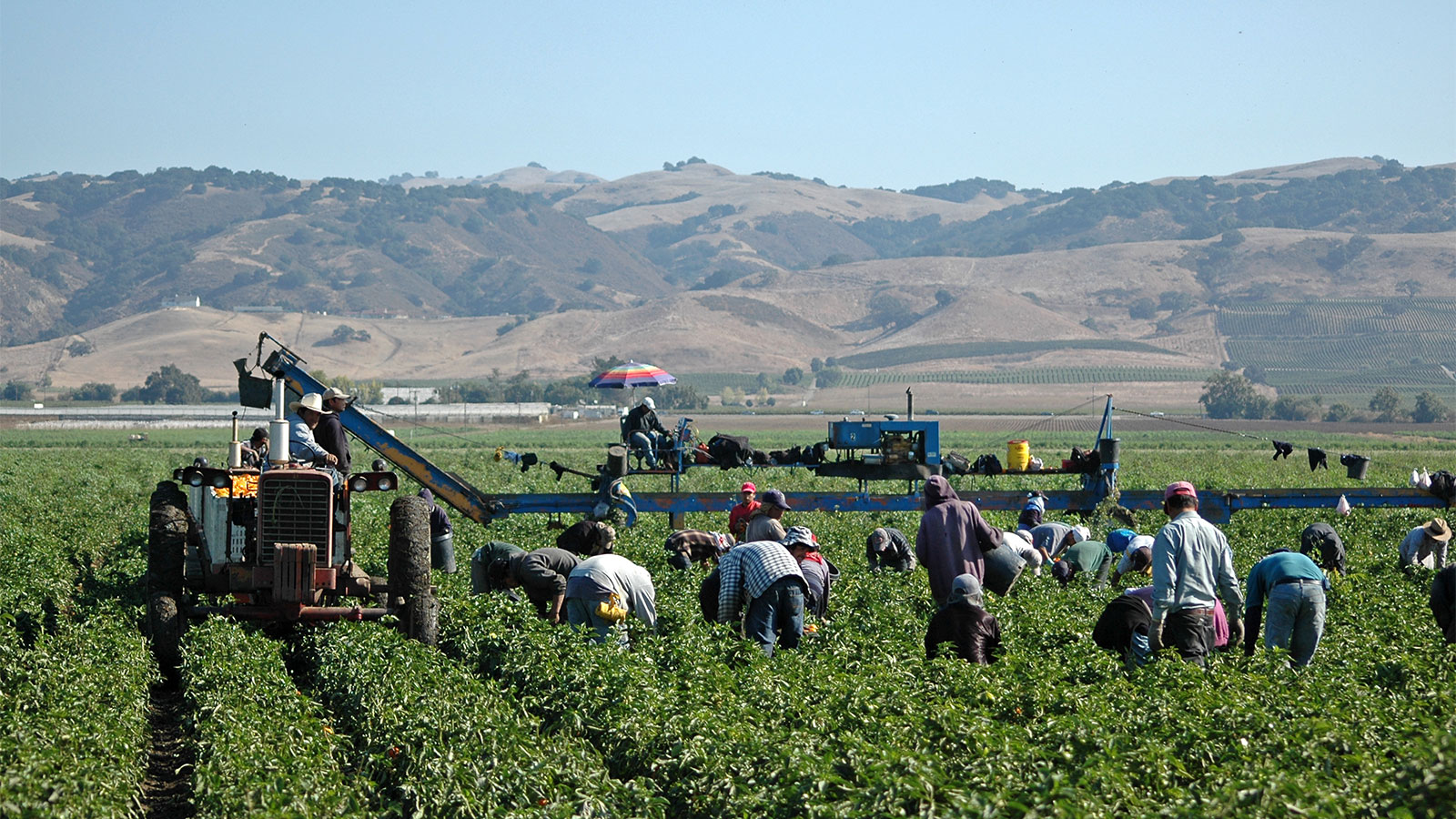An estimated 2.4 million people work on farms in the United States. Though their work is critical to agriculture and the economy alike, pesticide exposure continues to be a major occupational risk—and the effects ripple out into society and the food we eat.
Pesticides can easily drift onto farmworkers—and the schools and neighborhoods near fields. Current pesticide regulations aren’t consistently enforced, and vulnerable workers aren’t always able to seek help when there are violations.
Exposures may continue around the clock, especially on farms where workers and their families live, says Olivia Guarna, lead author of a recent report, “Exposed and at Risk: Opportunities to Strengthen Enforcement of Pesticide Regulations for Farmworker Safety,” by the Center for Agriculture and Food Systems at Vermont Law and Graduate School, in partnership with the nonprofit advocacy group Farmworker Justice. This is one of a series of reports addressing needed policy reforms and federal oversight of programs impacting farmworkers.
Alongside faculty and staff in the Center for Agriculture and Food Systems, Guarna, a honors summer intern with a background in environmental issues, spent 10 weeks interviewing attorneys, officials, administrators, legal advisors, and farmworker advocates, researching how pesticide use is regulated and enforced in Washington, California, Illinois, and Florida. What Guarna didn’t expect was just how complicated the regulatory scheme is. The federal Environmental Protection Agency technically has oversight over pesticide use, yet in practice receives little data from states, whose enforcement is spotty at best. “There are a lot more protections on paper than I think are actually being implemented to protect farmworkers,” she says.
One of the biggest issues, according to Laurie Beyranevand, Director of the Center for Agriculture and Food Systems and one of the authors of the report, is that unlike other environmental laws administered by the EPA, the agency doesn’t adequately gather data from the states, making enforcement of existing standards more difficult.
In Florida, the report found, inspections are virtually never a surprise. “Farmworkers report that when inspectors come to the farms, growers know they are coming, and they get to prepare,” says Mayra Reiter, project director of occupational safety and health for Farmworker Justice. “Inspectors don’t get to see what goes on day-to-day in those workplaces.”
Washington is considered one of the more progressive states in terms of farmworker protections. Yet between 2015 and 2019, Guarna discovered the average violation rate there was 418%, meaning that multiple violations were found on every inspection performed.
In California, when violations are found, fines are often not levied, the report concluded. Even when penalties are issued, they’re often for amounts like $250 — token fines that growers consider to be part of the cost of doing business. Only a single case reported in California between 2019 and 2021 involved a grower being fined the more significant sum of $12,000.
Still, California is one of the few states that makes information readily available to the public about what chemicals are being applied where. Elsewhere, it’s virtually unknown. Washington, Florida, and Illinois do not require pesticide use reporting at all.
“You have the farmworkers being directly exposed, and there’s so little transparency on what’s in our food,” Guarna says. “It’s not just farmworkers who are affected — drift is a big problem when it’s close to schools and neighborhoods. There’s just so little we know. A lot of the health effects happen years down the road.
In some instances, toxic exposure has become quickly and tragically evident when babies are born with birth defects. Within a span of seven weeks in 2004 and 2005, for example, three pregnant farmworkers who worked for the same tomato grower, Ag-Mart, in North Carolina and Florida, gave birth to babies with serious birth defects, like being born without arms or legs. Florida’s Department of Agriculture and Consumer Services issued two complaints against Ag-Mart in 2005, alleging 88 separate violations of pesticide use laws altogether. Ultimately, 75 of those violations were dismissed. Ag-Mart was fined a total of $11,400.
Yet thousands of poisonings continue to happen each year, Farmworker Justice says. In August 2019, for example, a field of farmworkers in central Illinois was sprayed with pesticides when the plane of a neighboring pesticide applicator flew directly overhead, the report noted. Several workers turned up at local emergency rooms with symptoms of chemical exposure.
Despite these incidents, Illinois does not mandate that medical providers report suspected cases of exposure. Only because a medical provider at the hospital personally knew someone in the local public health department—who in turn contacted connections at the Illinois Migrant Council and Legal Aid Chicago—did the exposure result in legal action.
Workers often live on the farms where they work, exposing them to chemicals virtually round-the-clock, Reiter adds. “We know from farmworker testimonies that when they return to their homes, they can smell the pesticides, and it lingers for days after they return,” she says.
Vulnerable legal status can make it difficult for farmworkers to report exposures. Millions of farmworkers hail from Mexico, Guatemala, and elsewhere in Central America, according to Farmworker Justice, although significant numbers also come from countries like Jamaica and South Africa. An estimated half of farmworkers in the U.S. are undocumented.
Millions of others come on H2-A guest-worker visas that allow them to come to the country for seasonal jobs of up to 10 months. These temporary visas are tied to specific employers, so workers fear being deported or otherwise retaliated against if they raise complaints about safety violations.
“Because [workers] are looked at as expendable, they’re regularly exposed to neurotoxic pesticides that can be carried into their home settings,” says agricultural policy expert Robert Martin, who recently retired from John Hopkins Center for a Livable Future. “They’re largely immigrants, and they don’t have a lot of legal protections. The advocates they do have, like Farmworker Justice, are terrific, but they’re really taken advantage of by the system because of their legal status.”
Inherent conflicts of interest also present legal loopholes. The state agencies charged with enforcing federal and state pesticide safety laws, like state Departments of Agriculture, are often the same agencies that promote the economic interests of the ag industry. And farmworkers know it. “That sort of cultural conflict is a big issue,” Guarna says. “Farmworkers have become deeply skeptical of departments of agriculture, and skeptical that they have farmworkers’ interests at heart. They fear their complaints are going to fall on deaf ears.”
While the EPA is legally required to maintain oversight over state agencies, in practice, they only require states to report about federally funded work—and the vast majority of state programs are funded by state budgets. Mandatory and universal standards for inspections and responses to violations would help tremendously, the report concludes. “One of our recommendations is that there should be whole-of-program reporting where states, tribes, and territories have to report all their activities,” Guarna says. “There are some very discrete fixes that can be made that would have a huge impact, so I am hopeful about that.”
Among the report’s 17 policy recommendations is to ensure that enforcement of pesticide safety gets delegated to an agency that is specifically tasked with protecting the health of workers. This could include transferring enforcement to state departments of labor or health, or even creating a new authority specifically dedicated to pesticide regulation.
“Exposed and At Risk” follows a previous report from the Center for Agriculture and Food Systems that focused on the two major threats facing farmworkers—heat stress and pesticide exposure. It focused on opportunities for states to take action to better protect farmworkers, and was written in collaboration with the Johns Hopkins Center for a Livable Future. That collaboration also led to a third report, called “Essential and in Crisis: A Review of the Public Health Threats Facing Farmworkers in the U.S.,” which recently explored the public health and environmental impacts of industrial agriculture. Martin, who co-authored these findings, explains that the concentrated power and wealth of large agribusiness companies has consequences for both worker safety and the environment.
Following corporate consolidation since the 1980s, “there are fewer meat, seed, pesticide companies, and their combined economic power really keeps the status quo in place,” Martin says. ”There are some pretty direct public health threats of these operations.”
As “Exposed and at Risk,” notes, the regulatory system should be structured in a way that works to protect farmworkers. But currently, federal regulators lack sufficient data to even identify the tremendous gaps in enforcement. Requiring states to develop comprehensive reporting systems would be a small step toward protecting the foundation of American agriculture.
Vermont Law and Graduate School, a private, independent institution, is home to a Law School that offers both residential and online hybrid JD programs and a Graduate School that offers master’s degrees and certificates in multiple disciplines, including programs offered by the School for the Environment, the Center for Justice Reform, and other graduate-level programs emphasizing the intersection of environmental justice, social justice and public policy. Both the Law and Graduate Schools strongly feature experiential clinical and field work learning. For more information, visit vermontlaw.edu, Facebook, Twitter and Instagram.




